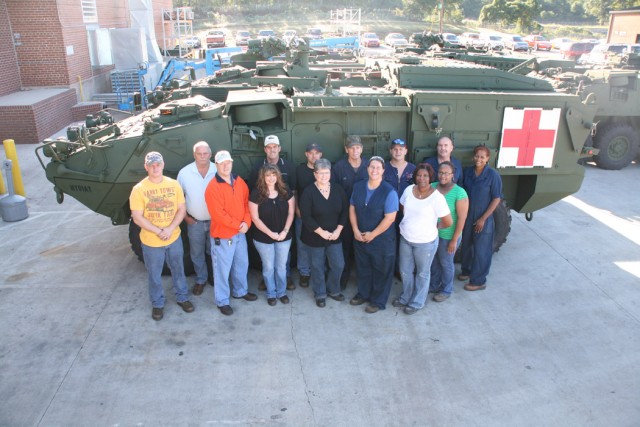The depotAca,!a,,cs Stryker production team responsible for repairing battle- and combat-damaged vehicles did more than just mend a Stryker medical evacuation vehicle, or MEV, that had returned from Southwest Asia.
From April 2008 to September 2009, MEV No. 19 was completely restored.
Anniston Army Depot and partner General Dynamics Land Systems performed on the MEV what vehicle program managers in the Army would typically describe as an overhaul, something workers at ANAD have done with combat vehicles since the 1950s. For Strykers, though, the current programs donAca,!a,,ct call for overhaul work, only new production or repairs and upgrades.
At maintenance depots, overhauling a vehicle involves complete disassembly, the refurbishment or replacement of all parts of the vehicle, and then reassembling it to a like-new condition.
This Stryker restoration project was a first for the depot and took a year and a half to complete.
While the work on this battle-damaged MEV isnAca,!a,,ct formally being called a vehicle overhaul, Jim Swann, representing the Program Manager-Stryker Brigade Combat Team, said this project gives the Army leverage as it looks at potential overhaul work for Strykers coming back from war.
Aca,!A"We just want to thank the depot and General Dynamics for rebuilding this vehicle, as itAca,!a,,cs now fully mission capable and is being handed back off to the Soldiers.
This is the first (Stryker) vehicle that workers have disassembled down to a bare hull and rebuilt,Aca,!A? said Swann.
The MEV arrived on depot April 19, 2008, and mechanics performed a standard inspection to assess the damage the eight-wheeled vehicle sustained in battle. The MEV is a uniquely equipped Stryker variant that serves as either a mobile aid station or an armored ambulance.
Aca,!A"Because of the damage it had, this vehicle is one theyAca,!a,,cd normally demil or scrap, but the PM wanted to see if the depot could rebuild it instead of replacing it with a new one,Aca,!A? said Kenny Duncan, a depot mechanic.
Before workers could begin the refurbishment process, they had to put the vehicleAca,!a,,cs metal through a hardening test to determine whether or not the material could sustain the rebuilding process.
If it hadnAca,!a,,ct passed the test, the vehicle would have been cut into pieces by the Defense Reutilization Marketing Office and shredded into scrap metal.
The metal was hard enough for the special project, so production planners ordered parts through GDLS, the vehicleAca,!a,,cs original equipment manufacturer occupying facilities on depot where new Strykers continue to be built.
The project touched many hands in the Directorate of Production.
Welders in the depotAca,!a,,cs Stanley Maintenance Facility produced a new hull from the raw material. The hull was delivered to the Stryker Repair Facility in July 2009 and mechanics went to work on the suspension. Meanwhile, depot support shops contributed with the cleaning, sandblasting and painting of parts. The upholstery shop installed the interior armor.
Aca,!A"Once it was back in the Stryker repair shop, it went like a normal battle-damaged Stryker,Aca,!A? said Duncan.
Reassembly and testing took place in August, and the vehicle was accepted by the Defense Contract Management Agency on Sept. 10.
Aca,!A"TheyAca,!a,,cre (DCMA) happy with it. This project was conducted to see how it would work in our partnership with GDLS and with the parts that would be needed in a program like this,Aca,!A? said Steven Smith, lead mechanic in the Stryker repair shop.
Smith said Stryker parts are ordered from many areas of the country, indicating that this project proved that the different agencies and businesses involved in a potential Stryker overhaul program could work together.
Aca,!A"We produced it faster than what we were expected to do,Aca,!A? said Smith. Aca,!A"The shop did a great job on the vehicle. It was meticulous work. There was nothing salvageable, but now itAca,!a,,cs like new or better.Aca,!A?
Aca,!A"IAca,!a,,cm pretty proud of it,Aca,!A? said Duncan.




Social Sharing